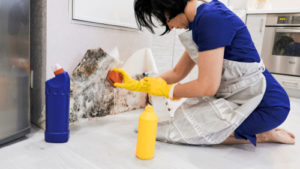The Unexpected Symptoms of Mold Exposure
Do you ever experience mood swings, brain fog, chronic congestion, hormonal issues that won’t resolve, or have trouble focusing?
Believe it or not, toxic mold exposure can be at the root of all these symptoms (and that’s just the short-list).
In today’s article, you’ll learn all about the silent epidemic of indoor mold toxicity, including:
- A full list of signs and symptoms
- Where mold hides out
- How to determine if your symptoms are mold-related
- And tips for mold abatement in your home
The silent epidemic of mold toxicity
When most of us think of mold, we typically picture older buildings, vacation homes, or basements with that characteristic musty smell and damp air.
And while these dwellings are certainly hotbeds for mold, the truth is any building or automobile that’s ever suffered water damage—from a roof leak to a busted pipe—is susceptible to mold.
Especially if the water damage wasn’t caught early and/or was not cleaned and dried properly.
This includes homes, vehicles, office buildings, churches, schools, barns, greenhouses, etc.
Thus, it is not at all uncommon for people to suffer from the effects of daily mold exposure without even knowing it.
Plus, most doctors don’t think to test for it! In fact, they will most likely look at you crazy for bringing it up!
Which means countless adults and children are being mis-treated for diseases—from asthma to autoimmune conditions—rooted in toxic mold exposure.
The lesser known symptoms of mold toxicity
Since chronic mold exposure affects so many of your body’s organs and systems, it can create a variety of mysterious symptoms including[1],[2],[3],[4]:
- ADD/ADHD
- Anxiety
- Asthma
- Autoimmune disease
- Balance problems/vertigo
- Chronic inflammation
- Chronic upper respiratory and lung conditions
- Cognitive health impairments such as poor memory and brain fog
- Compromised immunity (getting sick all the time)
- Depression
- Difficulty breathing
- Digestive health issues
- Excessive thirst or urination
- Fatigue
- Fever
- Hormonal imbalances
- Insomnia and other chronic sleep issues
- Joint pain
- Metallic taste in mouth
- Migraine headaches
- Mood swings
- Neurological symptoms
- Night sweats
- Sexual dysfunction
- Socialization issues
- Skin irritation and mysterious rashes
- Thyroid issues
- Tremors
Common types of indoor molds and where they hide out
When investigating the root cause of health issues, it always helps to know your enemy.
According to the CDC, the most common types of indoor molds are[5]:
- Cladosporium
- Penicillium
- Aspergillus
- Alternaria
Less common than other molds though not considered rare, the infamous “Black Mold” can be one of several types of fungus including Stachybotrys chartum.
Where indoor mold hides out:
Mold can grow anywhere it has moisture and a food source, including[6]:
- Attics
- Basements
- Bathrooms
- Crawl spaces
- Laundry rooms
- Skylights
- Sunroofs
Mold has also been known to grow within drywall, ceiling tiles, chimneys, and on pipes and wood, cardboard, paper and fabrics after flooding or water damage.
How do you know if your symptoms are associated with mold?
It’s all well and good to list out all these symptoms and diseases that can be triggered by mold…
…but how do you know if your autoimmune condition or your anxiety is rooted in toxic mold exposure?
This can get a bit tricky, especially given the limited testing methods available in mainstream medicine.
But, you can get to the bottom of this with a little detective work and help from the pros. Here’s what I recommend:
- If you suspect you have mold in your home due to visible mildew, a leaky basement, musty smell, etc., hire a reputable and thorough mold testing and abatement company.
- I recently used Enviro Testing and Solutions here in Pittsburgh.
- If you have no visible signs of mold or mildew in your immediate surroundings and have more than one of the symptoms listed above, OR have been trying to address one of the symptoms unsuccessfully, then have a Naturopath or healthcare practitioner proficient in addressing mold issues do some testing for you.
- I’ve had excellent results using BioEnergetic Assessment for this, but there are blood tests available too. Just make sure your doctor or practitioner knows what types of mold to test for. I am currently requesting the following from my pediatrician, per information I found in the very helpful book Is Your House Making You Sick? by Andrea Fabry: C4A, VEGF, MSH, and Leptin. I would also recommend a CBC and Metabolic Panel. In particular you may see imbalances in Alkaline Phosphatase due to liver stress.
- Functional medicine labs (like Great Plains MycoTOX Profile) look for the following markers in a urine sample to indicate the presence of mycotoxins: Aflatoxin, Ochratoxin A, Sterimgatocystin, Roridin E, Verrucarin A, Enniatin B1, Zearalenone, Gliotoxin, Mycophenolic Acid, Dihydrocitrinone, and Chaetoglobosin A.
- If your blood or BioEnergetic tests are indicative of mold toxicity, that means it’s time to start investigating where it’s coming from. Most likely, your home, car, office, church, school, or any building you spend a lot of time in.
Tips for Mold Abatement and Overcoming Toxicity and Allergic Reactions
The most obvious way to rid yourself of mold and its health impacts is to have it completely removed from your indoor environments.
However, sometimes that’s easier said than done.
First off, if you have a mold problem in your home your home insurance may not cover it; which could put you on the hook for a good chunk of change.
The cost of mold removal can run a few hundred dollars to several thousand dollars depending upon the extent of the damage.
So, if you do suspect mold in your home, now is the time to contact your insurance company to inquire about supplemental plans.
If you can afford to remove all the mold in your home immediately, I’d highly recommend you do that.
If you can’t, ask your mold abatement company where you should start (eg: removing black mold would be a top priority) and move as quickly as you can from there.
Secondly, if you suspect a mold problem at work or at your child’s school it will take some time and effort to get that resolved.
In the meantime, you can help lessen the effects of mold by:
- Controlling humidity—with a dehumidifier, proper ventilation, heating/AC, and opening windows. Remember, mold can’t survive without moisture and food.
- Diffusing Thieves essential oils—no, I’m not a Young Living rep, but Thieves has a cult-like following for helping minimize the effects of mold.
- Or you can make your own combination of the oils in the blend (which is what I do)…Cinnamon, clove, eucalyptus, rosemary, and lemon.
- Other essential oils shown to be effective against mold include: coriander, other citrus, citronella, lavender, peppermint, thyme, and tea tree[3]
- Have your air ducts cleaned.
- Change your air filters regularly (the mold company I used recommended to change them every 2 months!) and upgrade to a high-quality filter that targets mold particles. You can also have a UV light put on your furnace.
- Refresh the air in your home by opening your windows at least twice a day.
- Dust and vacuum regularly to remove mold spores.
- Invest in a high-quality air purifier(s) that removes mold particles (although the mold company I used claimed that these are not very effective).
- Talk to your practitioner about whether a mold detoxification program would be advantageous at this stage (often they can help alleviate symptoms while you get rid of the mold).
- Some safe herbal remedies you can try include: olive leaf extract, garlic, pau d’arco, thyme, and clove.
Should you DIY it?
Some sites claim you can remove small areas of mold by yourself using bleach (not effective—it only removes the color, it does not kill mold), tea tree oil, hydrogen peroxide, white vinegar or borax.
But should you? It depends.
If you’re already suffering from the effects of mold toxicity, especially in your lungs, you don’t want to be breathing toxic chemicals in.
Therefore, if you do decide to tackle a small area yourself I highly recommend:
- Using the most non-toxic products possible (note: even white vinegar is a lung irritant)
- Making sure the mold is very wet when you remove it
- Wearing a mask
- Opening the windows
- And using an air purifier and proper ventilation.
And for larger areas, leave that to the professionals.
I can’t emphasize enough the importance of considering mold toxicity as a potential contributing factor to your health issues.
I have seen this to be the case in so many patients. And it also has been a significant factor for me and in the health of my family members.
Mold toxicity can underlie so many health issues because it hijacks the immune system, causes liver and endocrine stress, disrupts the balance in the gut, and affects the neurologic system.
Of note, I have observed mold toxicity to compound and confound Lyme Disease.
If a patient has a particularly difficult time with Lyme detoxification, or their symptoms do not budge in response to a custom protocol, then most likely mold toxicity is to blame.
Take it one step at a time
I know that the whole topic of mold exposure, remediation and recovery from mold toxicity can be overwhelming, especially since it is such an under-reported and not commonly understood issue.
But it can all be handled, one step at a time.
And rest assured that a combination of guidance from an experienced practitioner, natural remedies (herbs, nutrients and in particular homeopathic mycotoxin detoxifiers), and specific interventions, especially:
- Infrared sauna
- PEMF
- Rife therapy
- And ionic foot baths (to name a few)
are so effective at eliminating mold toxins from the body and repairing all the systems that have been impacted by them!
The results can be quite amazing: resolution of chronic and often inexplicable issues with your health!
To schedule a BioEnergetic Assessment to check for mold, or other causal factors, click here.
In health,
-Dr. Joy
References:
1: https://www.sciencedaily.com/releases/2007/08/070829162815.htm
3: https://www.survivingmold.com/docs/Berndtson_essay_2_CIRS.pdf
4: https://www.frontiersin.org/articles/10.3389/fcimb.2018.00060/full
5: https://www.cdc.gov/mold/stachy.htm



